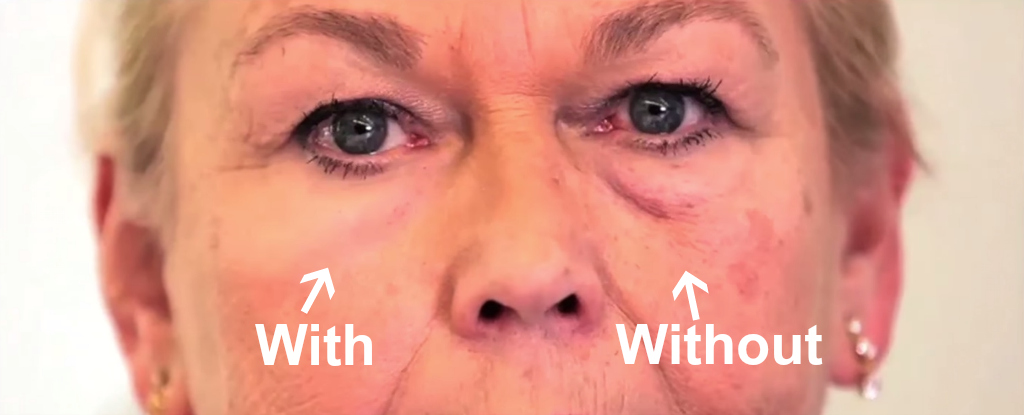For the first time, researchers have created a type of stretchy, polymer film that they're claiming acts like a 'second skin' barrier layer.
That's a big deal, because it means it could one day be used to protect us from sunburn and treat conditions like eczema, but what people are getting really excited about is the fact that it also seems to work like a face lift you can put on in the morning, wear all day, and then peel off at night - just like a pair of Spanx for your face.
The invisible coating is made out of cross-linked polymers and it goes on like a liquid before turning into a solid on the body, giving it some pretty cool firming and shaping properties - hence all the cosmetic interest.
One of the ways the researchers tested it was on people's eye bags, which, as you can see below, had some pretty impressive results. The researchers think the same thing could work for other body parts that have lost elasticity too, such as cellulite.
But even though the cosmetic benefits are obvious, the researchers have bigger picture applications in mind.
They're now working on engineering different medications into the polymer coating so that it could deliver drugs directly to patient's skin, without being washed off or ending up in the wrong areas - think eczema medication that's trapped on the area it needs to treat, and that also stops the skin from drying out and becoming irritated.
"It's an invisible layer that can provide a barrier, provide cosmetic improvement, and potentially deliver a drug locally to the area that's being treated," said one of the researchers behind the development, Daniel Anderson from MIT. "Those three things together could really make it ideal for use in humans."
In the future, if they can engineer different components into polymer material, it might even be able to work like a physical UV barrier to protect people from sun damage without having to constantly apply sunscreen.
That's not a bad thing, seeing as many of the UV-absorbing sunscreens we use have been shown to have some potentially harmful impacts on the body, and they're not great for the environment either.
So how do you turn polymers into a skin-like material? Described in Nature Materials, the new product is known as XPL, which is short for a cross-linked polymer layer. It gets its name from the fact that the silicone-based polymers its made from bind tightly with each other to form a strong but flexible film.
Practically speaking, this works by being applied to the skin in two liquid layers. The first transparent cream contains the polymer, which people rub into their skin. The second cream has a catalyst that triggers the polymer linking, creating an invisible film that can later be peeled off.
Once the film is set, it has remarkably similar properties to natural, youthful skin. Lab tests show it can bounce back to its original state after being stretched more than 250 percent (natural skin, even when it's youthful, maxes out at about 180 percent).
You can see it in action below:

Although it's a simple enough idea, finding a polymer with these properties was incredibly challenging, and the researchers had to create a library of more than 100 possible polymers before they found the right one that could mimic some of the properties of natural skin.
"It has to have the right optical properties, otherwise it won't look good, and it has to have the right mechanical properties, otherwise it won't have the right strength and it won't perform correctly," said lead researcher Robert Langer.
The team has since tested the film on more than 300 people for a range of different properties, such as hydration and flexibility. One test showed that, after 24 hours, participants wearing film retained more moisture in their skin than those who'd used vaseline or high-end moisturisers.
Another showed that the film was pretty much invisible for an entire day - for only two out of the 25 women tested, the edge of the film became noticeable after 16 hours of wear.
None of the participants in any of the studies reported any irritation from wearing XPL. The team is now investigating the best commercial applications of the material (which seem pretty obvious…) and the quickest way to get this to market. But that isn't as straightforward as it might seem.
"All of the components have been used in patients before and we've it tested it in over 300 people but, that being said, you have to do more," Langer told Gary Stix over at Scientific American. "I should say it appears to be safe for everything we've done - the ingredients, their history and the trials that we've done - but none of this has been FDA approved yet."
Here's hoping this new material might really work as an alternative to a slew of expensive moisturisers and cosmetic surgeries, but more than that, let's hope it can also offer a new way to protect our skin and also deliver medication in the future.
In the meantime, we know what you guys are thinking, and we're right there with you:

